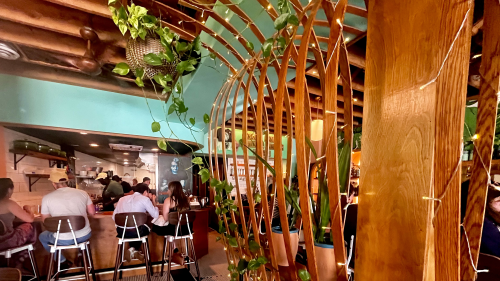Whether you’re a “wake up to the sound of birds” type, or a “please be quiet I’m trying to sleep” type, we’re all getting a new soundtrack to our Madison mornings.
Here’s the pitch: Imagine getting out of bed in the morning, sitting out on the patio, or going for a hike. Instead of just a bunch of noise, you hear the songs of warblers and American Goldfinches. You could even learn their colors, habits, and favorite foods. The upshot: You should really get into birdwatching.
You could wing it, or…
A little bit of preparation goes a long way — i.e., you don’t need to drop your tax return on binos (although it couldn’t hurt to look).
What might help:
- A field guide. Instead of trying to name them all on your own, bring a physical guide like the Wisconsin Dept. of Natural Resource’s viewing guides or an app like Merlin. If you bring your favorite local newsletter, too, we wouldn’t hate it.
- Bird food. A backyard or window feeder brings the birds to you. Try birdscaping your yard with native plants or learning how to properly feed birds.
- Your new best birdie. Local experts + hobbyists will love to show you the ropes. Link up with Madison Audubon for their next field trip, BIPOC Birding Club of Wisconsin, or the Feminist Bird Club so you aren’t flying solo.
- The Great Wisconsin Birdathon. The state’s largest fundraiser for bird conservation, with a goal of raising $100,000 by June 15 #ForTheBirds. A walk-a-thon style competition, join a team, or donate to those helping the birds.
Meet the stars of the show
Warblers are a group of birds with 53 species in North America alone. Wisconsin is home to dozens of different warblers, with the yellow-throated and the Blackburnian spotted recently around the Isthmus. Migration of the birds can be seen at the Lakeshore Nature Preserve frequently through the end of May.

Listen to the infamous chirp. | Photo by Aaron J. Hill via Pexels
The American Goldfinch also calls the Badger State home. They molt their feathers twice a year, with the brightening yellow of the males signaling the start of spring. The bird is notably known for its “po-ta-to-chip” calls during its bouncy flight.

Quack like a duck. | Photo via Wiki Commons
The namesake of our local baseball team — the Mallard — calls ponds, parks, and wetlands across North America home. You can identify it by the male’s green head, gray flanks, and black tail curl.

Spotted the UW-Madison Arboretum | Photo by @waunakee_photo_enthusiast
The Northern Cardinal is commonly found east of the Great Plains + is the official state bird of seven states. Males take on the iconic bright red color, while females are a muted pale brown with warm reddish tinges.










